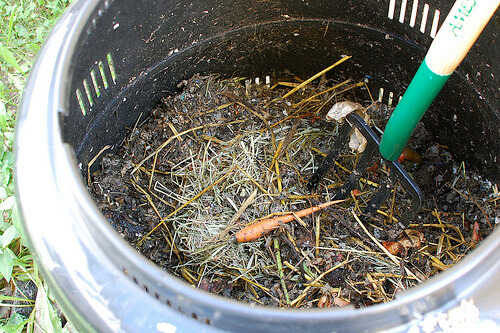
Composting is nature’s own recycling program. It’s her way of restoring vital organic matter and nutrients back to the earth, helping to create healthy soil and plants. More and more people are following nature’s lead, turning yard waste and kitchen scraps into beautiful, rich compost that enhances the soil of home flower and vegetable gardens.
There are lots of ways to compost, but whatever method you choose, you’ll want keep these tips in mind.
Ingredients: What to use and what to avoid.
The basic ingredients for the home compost pile or bin are food scraps and yard waste.
Food scraps: Avoid using animal products, such as meat, bones, and even dairy. Egg shells are the exception (it’s a good idea to crush the shells into small pieces). Just about everything plant-based that comes from the kitchen is fair game: peels and trimmings from fruits and vegetables, coffee grinds and tea leaves – even those few drops of wine at the bottom of an empty bottle (the wine contains microorganisms that help break everything down). But skip the moldy melon or rotten tomato – you don’t want mold to spread throughout your compost mix.
Yard waste: Leaves, twigs, grass clippings – these are all excellent additions to the mix. You can even mix in a handful of soil from time to time – like wine, soil contains microorganisms that help break things down.
Balancing the mix: Air, moisture & more.
Don’t worry about making composting an exact science. So long as you avoid extreme conditions, nature will make sure your mix does what it needs to.
Air: Your mix needs air, so be sure not to use a completely sealed container. Aerate the mix at least once a week (more often is even better). How you do this depends your bin or pile. But the goal is to stir things up a bit to circulate air through the mix, and loosen up any clumped or matted material.
Moisture: The mix should be damp – not wet – like a kitchen sponge after you’ve squeezed out the excess water. You can get an overly soggy mix back in balance by adding dryer lint, used paper towels, or shredded newspaper.
“Brown and green” ingredients: Think of brown ingredients as dried out yard waste: leaves, twigs, lawn clippings that have lost their freshness or greenness. Dryer lint and newspaper also qualify as brown. Green ingredients include food scraps and fresh yard waste, such as lawn clippings right after mowing. Three parts brown to one part green is a good ratio for optimal composting. If your mix has an unpleasant odor, try adding more brown ingredients.
The container: Here, there are countless options – including not using one at all if you have the space and location to build your compost pile directly on the ground. What works best for you depends on how much material you’ll be composting or how much garden soil you want to enrich. For some, a simple box or trash can will do the trick. Others might want to buy a commercial bin or tumbler. The choice is yours.
It’s really amazing to see discarded food scraps and yard debris transform into beautiful, black gold for your garden. And if you have young kids, chances are they’ll love taking part. Don’t be surprised if they eagerly volunteer to add the kitchen scraps to the mix, gather up twigs and leaves from the lawn, or give the mix its weekly stir. Happy composting!

